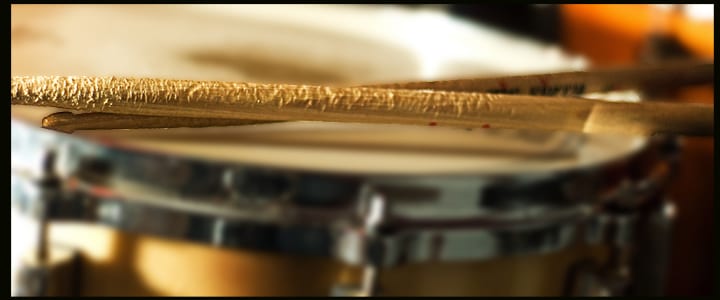When it comes to choosing a pair of drum sticks, there are a lot of factors that can influence your decision. Knowing what’s out there can help you decide which sticks are best for your drumming style. Here, Edmond, OK drum instructor Tracy D. breaks down the different types of drum sticks…
As drummers, we get to play a wide variety of instruments, and just as a painter uses many different brushes and tools in his or her arsenal, we should employ various types of sticks to achieve different effects. Those of you who venture into the broader world of percussion will have a particular interest in variety.
Here, I will discuss several types of drum sticks and their applications, so get ready to fill up your stick bag!
How Are Drum Sticks Made?
Before we get into the different types of drum sticks, let’s go over some drum stick anatomy.
Wood Type
Drum sticks are generally made of wood, and the type of wood can impact the durability. For example, oak and hickory drum sticks are durable, while maple is lighter, but less durable.
Build
The taper is the grade from the body to the tip of the stick. A thicker taper is best for loud, intense beats; while a more narrow taper is better for a lighter sound.
The tips are made of wood or nylon, and the shape of the tips affects the sound. Try an oval tip for a well-balanced sound, an acorn tip for a rich sound, or a barrel tip for high volume. You can also get drum sticks with a teardrop tip and a round tip.
Size
Have you ever wondered what the numbers on the drum sticks mean? They have to do with drum stick size. The number indicates the drum stick circumference. It may seem counter intuitive, but for the most part, a lower number indicates a higher circumference, so the 7A is smaller than the 5A.
The letters help to identify the application; the most common letters are “A” (orchestra), “B” (band), and “S” (street).
5A
The 5A is the most common type of drum stick. While they’re commonly used to play rock, you can use them for just about any type of drumming. The 5A is a middle-of -the-road drum stick, and a general-purpose tool.
7A
7A drum sticks are smaller and thinner. Because they are more lightweight than the 5As, they’re ideal for younger drummers and jazz musicians.
2B and 5B
These sticks are much heavier than the other two types, and as a result, they pack a lot more power!
Want to learn more? Check out this video for a behind-the-scenes look at how drum sticks are made.
Types of Drum Sticks
Now that you understand how drum sticks are made, let’s look at the different types of drum sticks!
Looking for something specific? Here’s what you will find in this section:
- Cheap Drum Sticks
- Beginner Drum Sticks
- Kids Drum Sticks
- Orchestral Drum Sticks
- Marching Band Drum Sticks
- Brushes
- Rods
- Timbale Drum Sticks
- Brooms
- Swizzles
- Brush / Stick Combos
- Effects
- Custom Drum Sticks
Cheap Drum Sticks
When you’re just starting out as a drummer, you may be overwhelmed by all the new gear. While a brand new drum set isn’t required for a beginner, you should at least have a decent set of drum sticks to use for practice.
While you may be looking for a pair of cheap drum sticks, I’ve got good news for you: most drum sticks are pretty affordable. In fact, most pairs are less than $8.
If you have a set budget in mind for drum gear, a basic pair of cheap drum sticks will be just fine to help you get started.
Beginner Drum Sticks
Beyond an affordable pair of drum sticks, many new drummers want to know if there are specific beginner drum sticks. Again, here’s where the letters and numbers come in. Many drum experts recommend 7As for beginners, especially kids, who are learning how to hold drum sticks, as well as proper technique and control.
5As are generally recommended for adults and teenagers since they’re ideal for drummers with average-sized hands.
Kids Drum Sticks
These sticks are great for smaller hands, and they’re made by some of the best-known companies.
Vic Firth Kidsticks
Vic Firth’s Kidsticks are 13″ long, designed for players aged three to eight, and come in pink and blue.
ProMark Future Pro Jr.

Image courtesy Musician’s Friend
ProMark makes the Future Pro Jr. sticks, which are the 5A diameter with a 13″ length.
Once you’ve been playing for a while and you’ve experimented with cheap drum sticks and beginner drum sticks, you will have a better idea of what you like and what feels comfortable. Now you’re ready to look into types of drum sticks that are best suited for the music you want to play.
Jazz drum sticks are usually light, long, and thin for finesse, while rock drum sticks are heavier, for power and volume.
Orchestral Drum Sticks

Image courtesy Professional Percussion Products
You can use these sticks on the snare drum in an orchestra or concert band setting, or for snare drum repertoire (not for chopping on hats!). This context requires particular nuance, and the sticks are designed with this in mind.
Some orehestral drum sticks are made with specialty woods, like persimmon, laminated birch, or rosewood, and they may be a bit more pricey (Cooperman, Malletech’s PhD Series), though there are some more budget-friendly options like ProMark, Innovative Percussion, and Vic Firth.
Marching Band Drum Sticks

Image courtesy taylormusic
These sticks are heavy duty and thicker, with large beads, as they must aid in projection and volume for play in a (primarily outdoor) large band setting—and be used on high-tension marching snare heads (made of kevlar, which is a thicker material than mylar).
Vic Firth, ProMark, and Vater have great marching band drum sticks.
Brushes
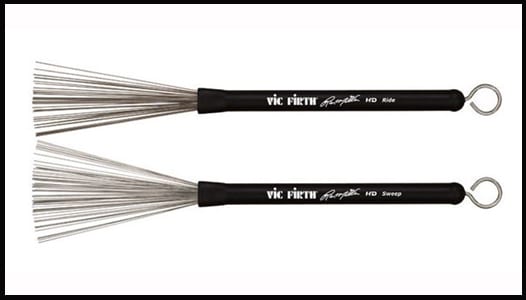
Image courtesy Steve Weiss Music
When it comes to types of drum sticks, don’t forget about brushes. While they’re mostly used in jazz settings, they’re great if you want a softer sound.
They may be drawn across the surface of the snare for a scratchy sound, and they’re also great for a Cajon (an Afro-Cuban wooden box percussion instrument).
Drum set brushes may have either nylon or metal bristles, and may or may not be retractable.
Rutes / Multi-Rods Drum Sticks
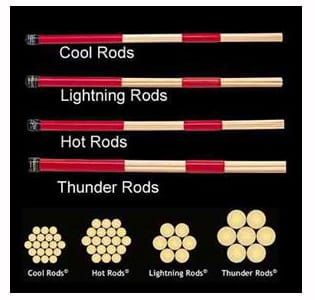
Image Courtesy AMPCO Musical Products
These deliver a softer attack than sticks and serve well in low-volume situations—or if you just want a different texture, they have a cool “chick” sound.
They’re made from a cluster of dowels of various diameters. Rutes made with thinner dowels will have a lighter sound. (Incidentally, these are fairly easy to make, and I have been doing so for many years).
Timbale Drum Sticks

Image courtesy Stew Weiss Music
You can use these sticks on timbales, blocks, and cymbals. They have a uniform diameter, with no bead.
Brooms / Cajon Brushes
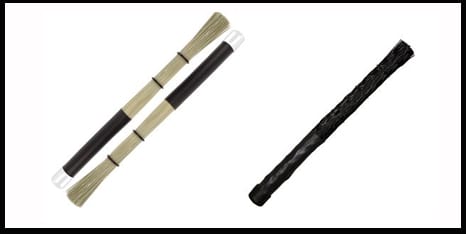
Image courtesy Interstate Music
These are great to use on Cajons, congas, and the kit. They have movable bands to allow for adjustment toward the handle for a softer attack—or toward the end for a more solid thump.
Swizzles

Image courtesy Sam Ash
These sticks have a bead (nylon or wood) at one end and a felt mallet tip at the other. They’re great for quick changes if you want to do some cymbal swells or tom work (and hey, it’s a chance to work on some spins).
Brush / Stick Combos
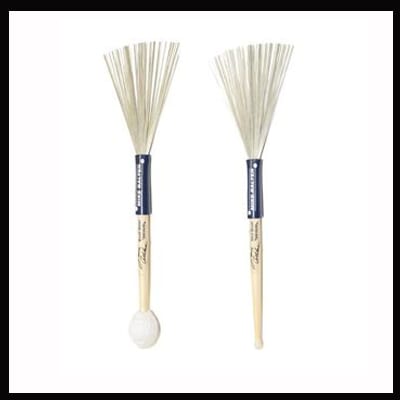
Image courtesy Interstate Music
These offer some great textural options with quick-change capabilities.
Effects

Image courtesy Intersate Music
It’s always fun to have some miscellaneous goodies, and here are a few items that can add a bit of seasoning to your groove:
ProMark’s TUBZ have an interesting attack and add a bit of their own tone to the mix.
Vic Firth’s Dreadlocks produce a pronounced attack on the snare, and give you cool options for scraping or striking your cymbals.
Flix products give you the best of both worlds: the sound of rods and the added durability of a built-in tip.
Custom Drum Sticks

Image courtesy Custom Stix
Custom drum sticks can be made with artwork of your choice, or the company’s art (for an art fee). So, if you’re interested in aesthetics, you may want to venture into custom territory.
Custom Stix is a cool company to check out, as well as West Virginia Wood Arts, which does custom laser engraving (on Vic Firth sticks) of words, your submitted images, or their own artwork. They also have different color options.
These are just a few of the many tools you can use to expand your tonal spectrum (and they make great stocking-stuffers). Experiment with different types of drum sticks, and find your favorites!
Want to know more about different types of drum sticks? Check out our gear guide to find out which drum sticks are the best!
Which type of drum sticks do you use when you play? Why are these your favorite? Let us know in the comments below!
 Post Author: Tracy D.
Post Author: Tracy D.Tracy D. teaches percussion and drum lessons in Edmond, OK, as well as online. She has been playing the drums with various bands for more than 13 years. Tracy earned her Bachelor’s in Music Education from Oklahoma Christian University and has played with the OKC Community Orchestra since 2009. Learn more about Tracy here!
Featured image courtesy Clint Pollan
The post From Brushes to Brooms: The Complete Guide to Drum Sticks appeared first on | TakeLessons.
